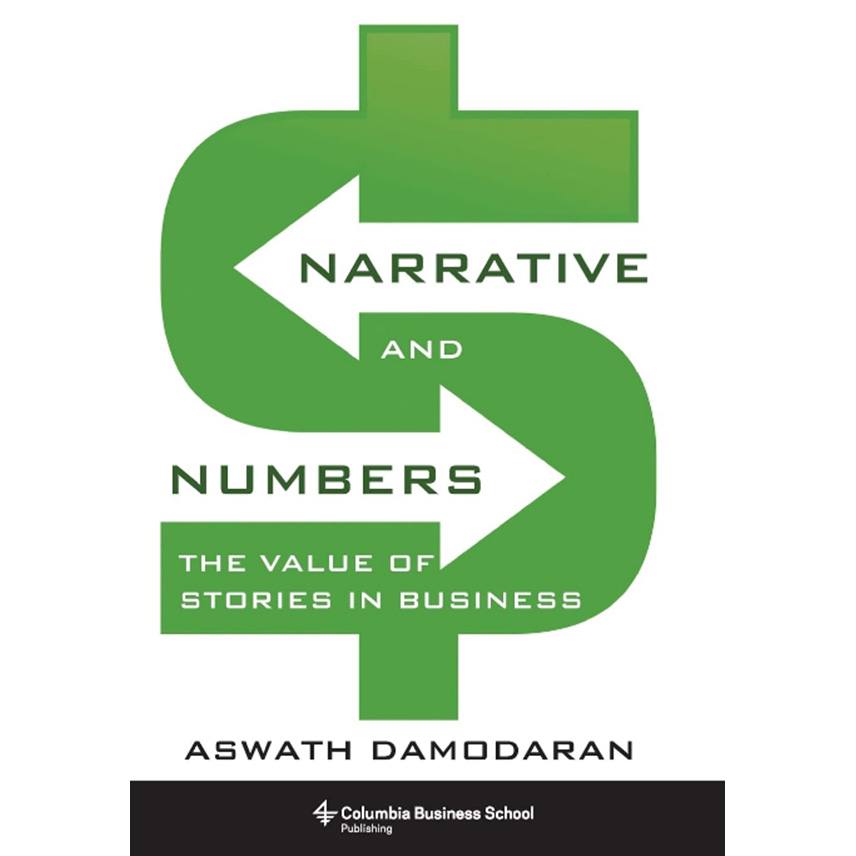Must Read
Annotated ideas from insightful books
Rigour of Numbers + Power of Stories = Convincing Narrative
Which tribe are you from?
What impresses you more? Numbers? Or a story? To figure that one out, consider the following example paraphrased from Prof Aswath Damodaran’s book Narrative and Numbers:
Imagine an investment banker trying to persuade you to invest in Ferrari, the legendary luxury auto company, when the company started off.
- Option A – The numbers: The i-banker makes a rational pitch. A valuation is shown in a spreadsheet with forecasted revenues, operating income, cash flows and key assumptions, all in numbers. You are told revenues will grow at 4 percent annually in the next five years, the pre-tax operating margin number, revenue generated per unit of currency. The impact: If you are not a numbers person, you would possibly feel lost and the data doesn’t register at all
- Option B – The story: The pitch is emotional. The presenter introduces Ferrari as a luxury automobile maker that appeals to the ‘exclusivity’ of the super-rich celebrity. Hence, can charge astronomically high prices, and can earn huge profit margins. The impact: You are of course more likely remember the story, but without specifics, will it influence you to invest in the company?
- Option C – The Narrative: The i-banker ties the low revenue growth (4 percent) to Ferrari’s strength in maintaining its exclusivity. He tells you how that same exclusivity will allow it to generate its huge profit margins and maintain stable earnings over time, since the wealthy who buy are unaffected by the ebbs and flows of the economy that affect other automakers. The impact: Most convincing because it blends the rational and the emotional, tying numbers to a story.
“That, in a nutshell, is the endgame for this book” says Aswath Damodaran, who is Professor of corporate finance and valuation at the Stern School of Business in New York University
Power of stories
Every profession attracts talent from diverse backgrounds. Not all professionals are wizards with numbers. Neither is every pro a spell binding story teller! Prof Damodaran’s book sets out to integrate the best of these two worlds to uncover the value of data-driven stories in business.
Insights for sales and selling
The book details insights on building convincing narratives drawing on the rigour of numbers and power of stories. Below is a curated selection of insights and quotes from the book valuable for sales and selling:
- a. Why Stories are powerful - Stories are powerful because (i) Stories connect (ii) Stories are remembered (iii) Stories spur action
- b. Data overload has made storytelling highly valued – “Assaulted by data overload, our brains stop processing the data …. and, storytelling gets us to pay attention and remember”
- c. Christopher Booker’s list of 7 story types – (a) Overcoming the monster (or any adversity) (b) Rebirth (or story of renewal) (c) Quest (or search for a perfect solution) (d) Rags to riches (or positive transformation) (e) Voyage and return (or emerging wiser, happier or richer from an experience) (f) Comedy (or humour through shared experiences of stumbling through challenges) (g) Tragedy (or humanising stories of unsurmountable difficulties)
- d. 6 Steps to tell a better story – (i) Understand your business and know yourself (ii) Understand your audience (and their interests) (iii) Marshall the facts (Use journalism’s 5Ws – Who, What, When, Where & Why) (iv) Talk in specifics (v) Show, don’t tell (Show how your product or service work and solve problems for your Customers) (vi) Have a good ending (Leave listeners excited and eager to act)
- e. 4 Ingredients of a good story – A good story is - (1) Simple (Core message delivered without distraction) (2) Credible (Meets the reality test) (3) Authentic (Reflects who you are as a person and what your business is truly about) (4) Emotional (Comes from the heart and resonates with audience)
Rigour of Numbers –
- a. Numbers inspire trust and confidence because (i) Numbers are precise (Notion that numbers are scientific and more precise than stories is deeply held”) (ii) Numbers are objective (Fair or unfair, numbers are unbiased and agenda free. Data doesn’t lie) (iii) Numbers indicate control (Measuring followed by analysis is the way to manage)
- b. Dangers with numbers –
- There are risks associated with numbers (1) Illusion of precision (Precision does not guarantee accuracy of results if the most relevant numbers are not chosen. Also results can be framed negatively or positively) (2) Illusion of objectivity (Data sets selected with biases will yield results that reflect the biases) (3) Illusion of control (Measuring something doesn’t mean you are controlling it, no matter how sophisticated your measuring tool is) (4) Intimidation factor (Numbers intimidate, cut off debate and prevent probing questions especially when the audience isn’t trained for uncovering weaknesses in the numbers/analysis) (5) Imitation problem (Purely number driven decision process is easy to imitate by machines but will be devoid of intuitive judgments that can spot non-quantifiable risks and benefits) (6) Herding problem (Widening availability of data and computing power, means many of us will work with the same humungous data sets, and possibly arrive at similar conclusions (herding). Leading to collective errors, which when taken together, can have serious implications.
Convincing Narrative
- 4 Building Blocks of a Good Narrative –
- (i) Must be simple (simple stories leave a more lasting impression than a complex story) (ii) Has to be credible (there must be no loose ends) (iii) Should inspire (Audience must buy into your story) (iv) Should lead to action (get audience to act, buy your products and services)
Using a range of case studies, short and detailed, numerous examples and illustrations spread over sixteen chapters, Narrative and Numbers aims, like Prof Damodaran’s valuation classes “to teach enough number-crunching to the right-brainers to make them disciplined storytellers, and enough storytelling to number-crunchers, to help them trust their imagination”
“Profit in business comes from repeat Customers, Customers that boast about your product and service and that bring friends with them”
– W Edwards Deming –
We look forward to hearing from you



Thank you. Your entries has been submitted successfully






